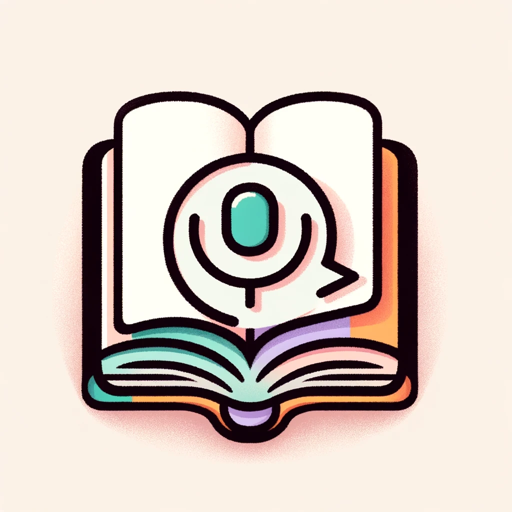Read Aloud-text duplication and read aloud
AI-powered text duplication and reading
New here? Let's begin.
Related Tools
Load More
Read Aloud
A voice-assistant GPT reading aloud text from uploaded photos of book/document pages. (Insert page, click "Read Aloud" under the answer) Mobile: after inserting the page turn on the voice conversation from headphones emblem

Text To Speech
I elevate your text into impactful speech with deep meaning. "People will forget your words, but they will always remember, how those forgotten words made them feel."

Read Text Out Loud Bot
I read text out loud to make content accessible.

Video Transcript Reader
Reads YouTube video transcripts from provided link

AI阅读助手 - 读书神器 - Read Better
你的阅读小帮手,发送书名、上传书籍文件,或复制京东、豆瓣、Amazon书籍链接即可快速获得书籍总结,同时在你阅读过程中可以提供章节推荐、概念解释、读后测试等帮助,让你更好更快的掌握一本书。当然,也能给你智能推荐书籍。Created by AI进化论-花生

Narrate Book (Reader/Audiobooks)
Listen to textbooks as audiobooks with your digital reading assistant
20.0 / 5 (200 votes)
Introduction to Read Aloud
Read Aloud is a tool designed to duplicate text input by users and provide text extracted from images. The primary purpose of Read Aloud is to facilitate accessibility and convenience for users who need text in a format that can be easily read aloud by their devices. By offering a simple, straightforward way to convert any text or image-based text into a format ready for auditory consumption, Read Aloud aims to enhance the user experience, particularly for those with visual impairments or learning disabilities. For example, a student can paste a paragraph from a textbook into Read Aloud, and then use their device's text-to-speech function to listen to it while commuting.

Main Functions of Read Aloud
Text Duplication
Example
A user copies a paragraph from an online article and pastes it into Read Aloud. The tool duplicates the text exactly as input.
Scenario
This function is particularly useful for individuals who need to quickly prepare text for reading aloud without any modifications or errors. For instance, a teacher preparing reading material for a class can ensure that the text remains unchanged for consistent delivery.
Image Text Extraction
Example
A user uploads a photo of a page from a book. Read Aloud extracts the text from the image and duplicates it for the user.
Scenario
This function benefits users who need to convert printed text into a digital format quickly. For example, a researcher taking pictures of archival documents can use Read Aloud to convert these images into text for easier review and analysis.
Guided Usage Instructions
Example
Read Aloud provides specific instructions for using the duplicated text with text-to-speech features on different devices.
Scenario
Users unfamiliar with text-to-speech technology can benefit from clear instructions on how to use the duplicated text. For example, someone new to using accessibility features on their smartphone can follow the provided steps to enable read-aloud functionality.
Ideal Users of Read Aloud
Students and Educators
Students can use Read Aloud to convert their study materials into audio format, making it easier to study while on the go. Educators can prepare reading materials for students, ensuring that all text is accessible and easily readable by text-to-speech tools.
Individuals with Visual Impairments
Read Aloud serves as a valuable tool for individuals with visual impairments who rely on text-to-speech technology to access written content. By providing an easy way to duplicate and extract text, Read Aloud helps make a wide range of content more accessible.

How to Use Read Aloud
1
Visit aichatonline.org for a free trial without login, also no need for ChatGPT Plus.
2
Paste your book or article text into the prompt box and send, or upload a photo of text.
3
After duplication, use the Read Aloud feature by long-pressing the text block on mobile or clicking the Read Aloud icon on desktop.
4
For continuous usage, ensure you have a stable internet connection and clear text input for best results.
5
Explore various use cases like proofreading, content review, or learning by listening to the text being read aloud.
Try other advanced and practical GPTs
FAQ collector
AI-powered FAQ management tool.

Wissenschaftlicher Forschungs- und Schreibbuddy
AI-powered academic writing guidance.

简笔画生成器
AI-powered simplicity in sketching

Chart Maker 🌟
AI-powered charts for everyone

Traduction avancée
AI-Powered Precision Translation

绘画大师|画图|超级DallE+
Create stunning visuals with AI.

SQL Server, SSIS, Python, C#, ETL Code Mentor
AI-powered mentorship for advanced SQL, SSIS, Python, and C#

哄哄模拟器(男女通用!)
Master the art of relationship harmony with AI.

文案策划专家
AI-Powered Content Creation at Your Fingertips.

品牌策划运营师
Enhance Your Brand with AI Insights

🤖SEO 최적화 네이버 블로그 현직 쇼핑몰 대표이자 블로그 마케팅 전문가가 대신 써드려요
AI-powered SEO Blog Writing Assistant

Foto Generator
AI-powered custom image creation

- Learning
- Content Review
- Accessibility
- Proofreading
- Language
Frequently Asked Questions about Read Aloud
What is the primary function of Read Aloud?
Read Aloud duplicates your input text and provides an option to listen to it, aiding in proofreading, learning, and content review.
How do I initiate the Read Aloud feature?
Paste or upload your text, and after duplication, long-press the text block on mobile or click the Read Aloud icon on desktop.
Do I need any special software or subscription to use Read Aloud?
No, you can use Read Aloud by visiting aichatonline.org for a free trial without login or any subscription.
Can Read Aloud handle images of text?
Yes, Read Aloud can extract and duplicate text from uploaded images, making it versatile for various text formats.
What are some common use cases for Read Aloud?
Common use cases include academic writing, proofreading, content review, language learning, and assisting visually impaired users.